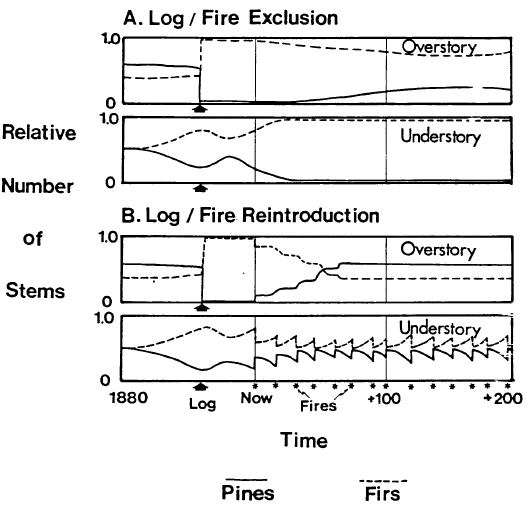Final Report, Forest Restoration of Sun Creek, Crater Lake National Park
Management Recommendations
Stocked Sugar Pine and Stocked Ponderosa Pine Logged Areas
The Short Run
Although logging significantly altered forest structure in these areas, subsequent regeneration of both pine species occurred. The pines only need selective survival over white fir in future years, and therefore fire can be used to restore “natural” forest structure in these areas. The same prescription recommended for unlogged areas (Table 4) can be used, but backing fires rather than strip headfires are recommended. A strip headfire might cause too much crown scorch on the pines, so a conservative application of fire is recommended. This should still reduce white fir density considerably, but protect the pines until they are larger and more fire resistant. This is particularly important for sugar pine logged areas, which contain moderately sensitive sugar pine poles on moderate to steep slopes.
Two fires about ten years apart are recommended. This will allow settling of dead fuels created by the first fire before the second fire.
The Long Run
As with unlogged areas, total restoration of “natural” structure within one forest generation will not be possible with the use of fire alone. Some of the trees in the post-fire suppression white fir age class are already large enough that they are as fire resistant as trees in the post-logging pine age class, which are 40-60 years younger. However, restoration of natural fire intervals as suggested for unlogged areas will in the long run favor pines in future generations.
The long run consequences of fire restoration in the logged but adequately stocked areas are shown in Figure 11. Under “A. Log/Fire Exclusion,” the wave of pine regeneration initiated by the logging will decrease over time. Some individuals will reach the overstory, but eventually a relatively pure white fir overstory and understory will develop. The scenario under “B. Log/Fire Reintroduction” will eventually produce a “natural” forest structure. The post-logging wave of pine regeneration will be augmented by continued pine establishment as understories will be opened and fir will be selectively killed. The overstory, which shifted to almost pure white fir after logging, will eventually readjust to a pine-dominated overstory with a substantial white fir component, similar to the structure at the 1880 (far left) time period.
 |
| Figure 11. Long term effects of management in logged but restocked areas. Under “A”, fire exclusion after logging remains in effect. Under “B”, fire is reintroduced to the environment. |
Other pages in this section

